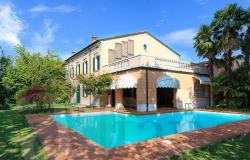 Mantua's 14th-century San Giorgio Castle has opened its doors to modern art for the first time, with an exhibit celebrating the sculptures of Italian abstract artist Lucio Fontana.
Mantua's 14th-century San Giorgio Castle has opened its doors to modern art for the first time, with an exhibit celebrating the sculptures of Italian abstract artist Lucio Fontana.
The castle, part of the Palazzo Ducale complex, once home to the Gonzaga ruling family of this northern Italian city, is displaying around 70 pieces of art by Fontana (1899-1968).
Most of the works are sculptures but there are also a number of drawings and preparatory sketches by the artist who is best known for founding Italy's Spatialist movement.
The exhibit seeks to strike a balance between Fontana's more traditional works and his abstract pieces.
It starts with a collection of his drawings, introducing visitors to some of the concepts behind his art, before moving into a number of his massive sculptures of the 1930s, including Campione Olimpionico (Olympic Champion), Il Fiocinatore (the Harpooner) and Paulette.
Campione Olimpionico, also called Athlete Waiting, is made entirely of blue-coloured plaster and was one of the works Fontana was most fond of, choosing it to represent him at an important 1935 exhibit in Rome.
The next section focuses on his ceramics from the 1940s, which are energetic pieces conveying movement. This part includes his Testa di Medusa (Head of Medusa), Portrait of Teresita and Il Gallo d'Oro (The Golden Cockerel).
Another important piece from this era is his Mujer con Mascara (Woman with Mask), completed in Buenos Aires in 1940. The life-sized clay figure of a woman is entirely painted in gold, her face covered with a black mask.
The next section looks at his later, more abstract sculptures, bearing the powerful slashes and irregularities that were characteristic of his work.
Fontana, born of an Italian father and an Argentine mother, spent his early years in Italy, before moving to Argentina and then returning to Italy as a young man.
The Mantua show highlights his sculptures but he gained equal renown for his paintings, and is best known as the founder of Spatalism.
He published his first issue of the Manifesto Spaziale magazine in 1947, in which he developed a number of his earlier ideas, calling for art that embraced science and technology.
Transferring these ideas into practical art, he made increasing use of neon light and radio. His 1949 installation, Ambiente Spaziale, is also on show in Mantua, set in the underground cellars of the castle.
In the 1950s he started work on his famous slash paintings, making vertical cuts or punching holes in the surface of his canvases.
This series of paintings, part of his abstract period, are probably the pieces most familiar to the general public.
They have had a lasting influence on modernist visions of art and fetch high prices in auctions today.
The Fontana exhibition runs in Mantua's Castle of San Giorgio in the Palazzo Ducale complex until January 6.







